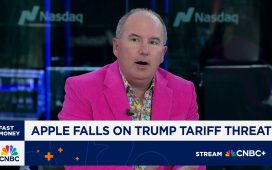Editor’s Note: This analysis was originally published as a stock note by Morningstar Equity Research.
Key Morningstar Metrics for Apple
President Donald Trump continued tariff threats on Apple AAPL on May 23. On his Truth Social platform, Trump indicated his desire for iPhone production to shift to the United States and claimed Apple would face a blanket 25% tariff for iPhones imported from India and other countries.
Why it matters: We don’t view US iPhone production as feasible in the medium term. To us, this is a negotiating tactic aimed at driving greater US investment from Apple, likely in the form of domestic chip investment and potentially production of lower-volume devices than the flagship iPhone.
- We had viewed China production at the highest tariff risk for Apple, but Trump is now targeting India, where more than half of US-bound iPhones are produced. Still, we believe paying the blanket 25% tariff would be more economical than mass-producing iPhones domestically.
- Apple has already announced $500 billion in US investment, which we think is aimed to placate the Trump administration and earn an exemption to tariffs. We believe the administration knows it has leverage over Apple via tariffs and is using this to gain greater commitments from the company.
The bottom line: We maintain our $200 per share fair value estimate for wide-moat Apple. We continue to model a tariff exemption in our base case. Despite short-term bluster from the administration, we expect an investment deal to be reached that avoids blanket iPhone tariffs.
- If Apple were to face a blanket 25% tariff on US iPhones, we’d expect a 5%-15% impact to earnings and the firm’s intrinsic valuation, depending on Apple’s decision to offset the cost via pricing (which could negatively impact unit sales).
- Shares look fairly valued to us, even after trading down 3% intraday on May 23 on the news. We believe tariff concerns are being adequately valued into the stock, along with concerns over Apple’s ability to use artificial intelligence to improve future growth, which we factor into our valuation.
The author or authors do not own shares in any securities mentioned in this article.
Find out about Morningstar’s editorial policies.







